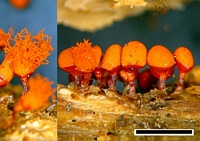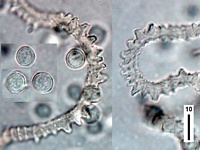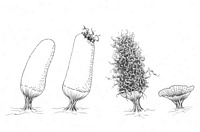|
 Arcyria incarnata Arcyria incarnata
SynonymsArcyria incarnata var. fulgens
Stemonitis incarnata
BiostatusPresent in region - Indigenous. Non endemic
Images (click to enlarge)
Caption: scale=2mm
Owner: J.A. Cooper | 
Caption: spores and capilitium
Owner: J.A. Cooper | 
Caption: Three sporangia of Arcyria incarnata (on the left) and an empty calycyulus (on the right). Each sporangium is about 2 mm tall.
Owner: S.L. Stephenson |
Article: Stephenson, S.L. (2003). Myxomycetes of New Zealand. Fungi of New Zealand. Ngā Harore o Aotearoa 3: xiv + 238 p. Hong Kong: Fungal Diversity Press.
Description: Fruiting body a stalked sporangium, closely gregarious to crowded but occasionally scattered, 1–2 mm tall. Sporotheca cylindrical or nearly so, rose to crimson but sometimes weathering to reddish brown (rarely pale violet), 0.5–0.8 mm in diameter. Stalk usually short, slender, weak, reddish brown, up to 0.5 mm high. Hypothallus contiguous for a group of sporangia, colourless and shining, brownish red or dull red, often inconspicuous. Peridium persisting in mature fruiting bodies only as a distinct calyculus, the latter small, shallow or funnel-shaped, pink, usually plicate, asperulate or minutely spinulose inside. Capillitium greatly expanding in length and strongly elastic, deciduous, consisting of filaments 3–5 µm in diameter, marked with more or less spirally arranged half-ring, cogs, and transverse plates. Spores pink in mass, nearly colourless by transmitted light, marked with a few scattered warts, 6–8 µm in diameter. Plasmodium white.
Habitat: Decaying wood and (less commonly) bark.
Distribution: Cosmopolitan (Martin & Alexopoulos 1969). First reported from New Zealand by Lister & Lister (1905), based on a specimen from Stewart Island. Also known from Auckland (Cheesman & Lister 1915), Taupo, Wellington, Nelson, Fiordland, and Southland.
Notes: This species can be recognized in the field by the combination of the rose to crimson colour of the sporangia, and a capillitium that is strongly elastic and often detached completely from the shallow dish-shaped calyculus in mature specimens.
|